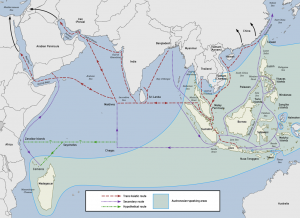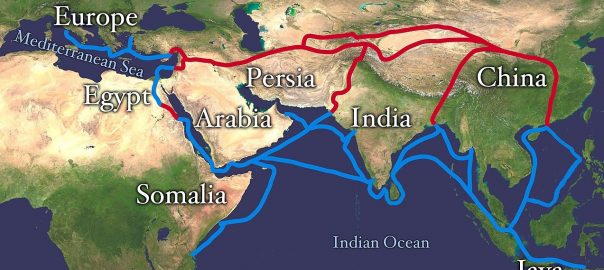There was not as much happening in 1523 CE in the key areas I’m tracking, as there had been the preceding years. (To be honest, things going on in Scandinavia at that time leave me yawning.)
But here’s what I have picked up:
- Martin Luther published his translation into German of the Pentateuch (the first five books of the Hebrew Bible), some time in around July.
- In September, Spanish conquistadores conquered Nicaragua.
- Ming dynasty navy boats captured two Western ships with Portuguese breech–loading culverins aboard, which the Chinese call a fo–lang–ji (Frankish culverin.) These were reportedly later presented to the Jiajing Emperor by someone called Wang Hong, and their design was copied.
Okay, I realize this latest “Ming dynasty gets hold of advanced Portuguese military technology” story is a little different from the one I presented in the 1522 post. I have no way of knowing which one was more accurate. The broader point, I think, is that the Ming Dynasty administration was evidently on-guard in face of the arrival of Portuguese war vessels, and was capable both of capturing some of their weaponry and then, it seems, of reverse-engineering the culverins. Not shabby.
All this indicates significant Ming-dynasty capabilities…
Anyway, since I didn’t find many actual items to put into my list above, and since it is a rainy weekend, I want to put the following little extra “Note” into this post:
The Indian Ocean before the arrival of Europeans
I am a child of the Atlantic world. I was born “White” in England and had a traditionally conservative British upbringing. My father was a big Americo-phile– a tendency that had been strengthened by his service in WWII alongside US troops. As a young adult, I had an eventful seven-year sojourn in Beirut but then I ended up here in the United States in early 1982 and have lived here ever since. In the various phases of thinking and writing that I have done about various phases of world history, I have generally had a fairly strong Atlanto-centric focus to my thinking, which here in the United States is a very conventional way of looking at the world.
However, looking at the history of the world in the 15th and 16th centuries CE, as I am doing in this project, several thoughts have occurred to me:
- One is to reconnect with some questioning I have long had in mind, as to why it was the European countries of the Atlantic seaboard that developed large world empires– though once you see the key role that long-haul maritime capabilities play in establishing and then maintaining a glob-circling empire, the answer to that becomes fairly obvious.
- Another is to probe the role that development of long-haul trade routes and then the empires that grew up around them played in midwifing the emergence of discrete and often mutually competitive “metropolitan” states in Europe itself. It was not, I think, that “Spain”, Portugal”, “England”, etc all existed in any recognizable, stable, or robust form before those countries developed empires. Rather, the “achievements” of the long-distance adventurers who established the global trading networks and empires, based out of various Atlantic-coast cities or regions in Europe, both necessitated and enabled the emergence of what came to be known as “nation-states” back home in those European regions themselves. (A question that needs to be explored much more, later…)
But here, what I really want to explore is the comparison between what the armed Spanish adventurers (conquistadores) were pursuing and achieving in the Americas, and what their Portuguese counterparts were pursuing and achieving in and around Africa– and crucially, all around the Indian Ocean.
The crucial difference between these two different forms of early European empire-building was, I think, that when the Portuguese adventurer Vasco da Gama rounded the Cape of Good Hope and entered the Indian Ocean in 1497, he was entering a maritime system in which lengthy string of economically advanced city-states had already, since the 4th century BCE, been intricately connected by maritime trade routes.
Kallie Szczepanski has written:
During the classical era (4th century BCE–3rd century CE), major empires involved in the Indian Ocean trade included the Achaemenid Empire in Persia (550–330 BCE), the Mauryan Empire in India (324–185 BCE), the Han Dynasty in China (202 BCE–220 CE), and the Roman Empire (33 BCE–476 CE) in the Mediterranean. Silk from China graced Roman aristocrats, Roman coins mingled in Indian treasuries, and Persian jewels sparkled in Mauryan settings.
Another major export item along the classical Indian Ocean trade routes was religious thought. Buddhism, Hinduism, and Jainism spread from India to Southeast Asia, brought by merchants rather than by missionaries. Islam would later spread the same way from the 700s CE on.
But actually, on the excellent page that Wikipedia has on Indian Ocean trade routes, their contributors conjecture that:
There was an extensive maritime trade network operating between the Harappan and Mesopotamian civilizations as early as the middle Harappan Phase (2600-1900 BCE), with much commerce being handled by “middlemen merchants from Dilmun” (modern Bahrain and Failaka located in the Persian Gulf).
And this:
The first true maritime trade network in the Indian Ocean was by the Austronesian peoples of Island Southeast Asia,[5] who built the first ocean-going ships.[6] They established trade routes with Southern India and Sri Lanka as early as 1500 BC, ushering an exchange of material culture (like catamarans, outrigger boats, lashed-lug and sewn-plank boats, and paan) and cultigens (like coconuts, sandalwood, bananas, and sugarcane); as well as connecting the material cultures of India and China. Indonesians, in particular were trading in spices (mainly cinnamon and cassia) with East Africa using catamaran and outrigger boats and sailing with the help of the Westerlies in the Indian Ocean. This trade network expanded to reach as far as Africa and the Arabian Peninsula, resulting in the Austronesian colonization of Madagascar by the first half of the first millennium AD. It continued up to historic times, later becoming the Maritime Silk Road.[5][7][8][9][10]
Here is the map that Obsidian Soul put onto that WP page, to illustrate that:

… So then, those Wikipedia contributors took a quick but well-documented gallop through the Hellenistic, Roman, Great Indian Hindu-Buddhist, Chinese, Japanese, and Muslim periods– all of whose trading networks, laid atop each other like a palimpset, absolutely antedated Portugal’s arrival. (The map at the top of the page here is a very schematic sketch of the maritime and land portions of the pre-Vasco “Silk Roads” that connected Europe with Asia.)
For Vasca and his Portuguese successors, tapping into these long-existing trading systems was a complex business that must have involved some very complex diplomacy. Yes, the Portuguese adventurers had some cool advanced military technology (which the Chinese, among others, clearly craved…) But in few places did the Portuguese have the ability simply to annihilate local people— and if they did, then what effect would that have on future trading prospects? Remember that behind most of the numerous entrepots in which Vasco and his successors established “Portuguese” trading posts were sizeable hinterlands, most of which were stably governed and heirs to the centuries-long cultural traditions that had generated the large range of “specialized”, “Oriental” spices and manufactured goods that the financiers of those voyager were so eager to buy up in bulk, in order to resell at a massive markup in the emerging European markets…
When Columbus and his people encountered the Americas and the islands of the West Indies, they too often encountered ancient civilizations. But their major goal was not building profitable, long-term trading relations with existing producers. It was plunder, looting, rapine, large-scale colonization, and land-theft. Almost certainly, in an area like the Caribbean basin, there had been long traditions of some degree of inter-port maritime traffic and trading. But none of the port cities there could compare with the highly sophisticated economic systems of India or China. The Aztecs and the Incas had large territorial empires, but seemed to have little interest in sea-borne trade… And neither did the “Spanish”! They were there firstly to steal the gold and silver and secondly to steal and colonize the land.
And we still haven’t even got to the English, French, Dutch, and other adventurers who came along some decades after the Portuguese and the Spanish sailors… Stay tuned!
